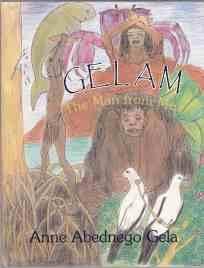
Title
Gelam the Man from Moa : A Legend of the People of the Torres Strait Islands
Author
Anne Abednego Gela
Illustrators
Anne Abednego Gela
Publisher, Date
Magabala Books, 1993
Audience
Primary, Upper Primary
ISBN
1875641092
Language
English, Kala Lagaw Ya language Y1
Add to Favourites
-
Subjects
- Childhood and youth
- Crabs
- Culture
- Dugongs
- Fear
- Fishing
- Glossaries and vocabularies
- Hunting and gathering
- Mothers
- Oceans
- Oral storytelling
- Relationship to place
- Torres Strait Islanders (Qld TSI SC54, SC55)
- Torres Strait Islands (Qld TSI SC54, SC55-05)
-
Annotation
In introducing the story, the author, Anne Gela writes that there are many versions of the legend of Gelam, and that this one was told to her by her mother’s relatives who came from Moa Island, where the story of Gelam is set.
Gelam, as the title of the story indicates, was from Moa and is a child when the story begins. He and his mother are left behind when all the people leave to escape an evil monster, a dhogai, that lands on the island. With the help of a sand crab, Gelam and his mother outwit the dhogai and then spend many years living alone on the island. Mother and son become rivals for the food Gelam hunts and Gelam determines to leave the island and his mother. His attempts to make a wooden dugong in which to escape were not always successful and the abandoned ones became large rocks on the shore. When he is finally successful, he takes with him the best of Moa’s plants and soil. Moa’s mother turned into a stone on Moa’s shoreline and Gelam himself sailed on until he reached a sandy island called Mer. There he turned into a giant stone dugong, thus creating the island of Mer which was now also has the finest vegetation of all the Torres Strait Islands.
Anne Gela both retells this story and illustrates it. Her illustrations show traditional dress, accommodation, canoes and hunting methods. The book is in three parts: the first telling of the arrival of the dhogai; the second tells of the ganaus, or pigeons that Gelam catches and the dispute over who gets the most and the final one is entitles The Wupudh Tree – the tree which Gelam uses to build his dugong.
Anne Abednego Gela is a Torres Strait Islander woman, from Thursday Island. Her husband is from the Torres Strait island, Erub. She has worked at the Dreamtime Cultural Centre in Rockhampton, an experience she said allowed her to ‘express [her] culture freely’. She has an Associate Diploma in Aboriginal and Torres Strait Islander Art from Cairns TAFE.
-
Teaching Resources
- State Library of Queensland 2011 ‘Picture This – The Story of Gelam the creator of dugong’ https://www.youtube.com/watch?v=l0oBFtlDwTs
- Brief biography of the author/illustrator Brief biography of the author/illustrator
- ABC Behind the News ‘Torres Strait’ https://www.abc.net.au/btn/classroom/torres-strait/10525912
- Queensland ‘An Art Lovers Guide to Torres Strait Culture’ https://www.queensland.com/au/en/things-to-do/indigenous/torres-strait-culture.html
